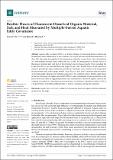Benthic Fluxes of Fluorescent Dissolved Organic Material, Salt, and Heat Measured by Multiple-Sensor Aquatic Eddy Covariance
Author(s)
Hu, Irene H.; Hemond, Harold F.
Downloadsensors-22-08984-v2.pdf (3.421Mb)
Publisher with Creative Commons License
Publisher with Creative Commons License
Creative Commons Attribution
Terms of use
Metadata
Show full item recordAbstract
Aquatic eddy covariance (AEC) is an in situ technique for measuring fluxes in marine and freshwater systems that is based on the covariance of velocity and concentration measurements. To date, AEC has mainly been applied to the measurement of benthic oxygen fluxes. Here, development of a fast multiple-channel sensor enables the use of AEC for measurement of benthic fluxes of fluorescent material, salt, and heat at three distinct sites in Massachusetts, USA, including the Connecticut River, the Concord River, and Upper Mystic Lake. Benthic fluxes of salt, useful as a tracer for groundwater input (submarine groundwater discharge), were consistent with independent measurements made with seepage meters. Eddy fluxes of heat were consistent with the balance of incoming solar radiation and thermal conduction at the sediment surface. Benthic eddy fluxes of fluorescent dissolved organic material (FDOM) revealed a substantial net downward flux in the humic-rich Concord River, suggesting that microbial consumption of dissolved organic carbon in the sediment was significant. Simultaneous measurement of several fluxes expands the utility of AEC as a biogeochemical tool while enabling checks for mutual consistency among data channels.
Date issued
2022-11-20Department
Massachusetts Institute of Technology. Department of Civil and Environmental EngineeringPublisher
Multidisciplinary Digital Publishing Institute
Citation
Sensors 22 (22): 8984 (2022)
Version: Final published version